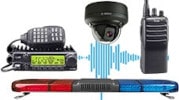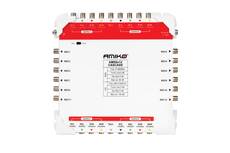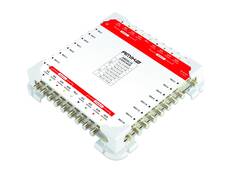- Special Offers
- Transceiver Radio
- Transceiver Accessory
- Antennas
- Antenna Accessory
- Antenna Rod and Radiator
- Magnet Mount for Antenna
- Drillable Antenna Base
- Antenna Mounting Bracket
- Antenna Mast and Fitting
- Antenna Switch and Coax Switch
- SWR Meter, Antenna Tuner
- Antenna Surge Suppressor
- Grounding Clamp for Coax Cable
- Antenna Rotator and Motor Driven Antenna Mount
- Antenna Dummy Load
- WiFi Antenna Splitter and Coupler
- Wingscrew
- Antenna Meter
- TV Antenna Splitter
- Multiswitches
- TV Antenna Combiner
- TV Antenna Amplifier
- LNB Head for Satellite Dish
- TV Headend
- Cable
- Connector
- Installation Material
- Installation Tools
- Measuring Equipement
- Body Worn Camera
- Electrosmog
- Telephone
- Baby Monitor
- Fever Thermometer
- Radio Device
- Set-top Boxes
- Personal Protective Equipment
- Motorcycle Helmet Speaker
- Car Equipment
- Voltage Converter
- Dry Cell
- Battery
- Battery Charger
- Emergency Signal
- Amber Signal
- Sound Signal
- Light and Sound Signal Accessory
- Traffic Engineering
- LED Lamp
- Smart Home
- Mosquito Repellent Device
- Market - Other Products
- Discontinued Products
Pre-order (2)
Multiswitches
The days of the whole family sitting together in front of the television in the evenings, excitedly choosing from the three channels available, are long gone. Our habits have changed completely. Since a combination of cooking and football channels in the same room is not desirable, the available channels need to be expanded to include more transmission options. Nowadays, almost every home has a television, and there is a huge choice of channels and programmes. Therefore, we need a multiswitch that distributes the DVB-S signal from the satellite dish and the DVB-T signal from the terrestrial antenna between 4-16 receivers so that each endpoint can watch all the channels independently. Read more...
Pre-order (2)
• Satellite and terrestrial inputs
• Capable of receiving 2 satellites
• Use it to switch satellite + ground antenna signals to 12 indoor units
• Cascade compatible (can be connected in series to increase the number of outputs)
• QUAD LNB support
• Attenuation: 0 dB (Sat), 16 dB (Terr)
• Isolation: 30 dB (Sat)
• Output Level (Terr): max. 95 dBµV
• Output Level (Sat): max. 95 dBµV
• Power Supply: 230V 50Hz
• DC Voltage: 13V / 18V
• DC Power (LNB): 1A (max)
• DC Power (12V): Ʃ 300mA (max)
• Satellite and terrestrial inputs
• Capable of receiving 2 satellites
• Use it to switch satellite + ground antenna signals to 16 indoor units
• Cascade compatible (can be connected in series to increase the number of outputs)
• QUAD LNB support
• Frequency Range: 47 ~ 2200 MHz
• Attenuation: 0 dB (Sat), 16 dB (Terr)
• Isolation: 30 dB (Sat)
• Output Level (Terr): max. 95 dBµV
• Output Level (Sat): max. 95 dBµV
• Power Supply: 230V 50Hz
• DC Voltage: 13V / 18V
• DC Power (LNB): 1A (max)
• DC Power (12V): Ʃ 300mA (max)
When do we need a TV multiswitch?
If a satellite dish is used to power more than one receiver, and you have not connected a Quatro satellite headend to your system to transmit the signal to four endpoints, you need a multiswitch. For example, if you want to watch different channels simultaneously in the living room, bedroom, children's room and perhaps the bathroom etc. and you want to feed all these endpoints with a signal from the same satellite dish on the roof, then such a device makes this easy to do.
This device is also the perfect solution for sharing a satellite system in a multi-family condominium. Because otherwise, in a detached house with many televisions, more than one satellite system would be needed, meaning that the TV multiswich acts as a sort of hub. The device distributes the satellite system's television reception to several televisions, like a Quad or Octo satellite receiver headend. So you need this device if you want to signal more than four TV sets.
How does a multiswitch work?
The easiest way to illustrate how this device works is to imagine a railway station, with the switch, or multiswitch, directing the signals to go where we want them to go. Just like locomotives, the switches make sure they get on the track where the switch directs them.
Connecting the multiswitch
In the long run, a satellite dish is much cheaper than a cable TV subscription, and it also offers more programming. The multiswitch is connected directly behind or directly to the satellite receiver head unit. The device labeling shows how many inputs and outputs the device has. The second number indicates the number of outputs, i.e. the possible endpoints, which usually range from 4 to 16. Note that the TV multi-switch cannot be connected to all LNBs. For most of these devices, you will need a Quatro LNB, as it has the necessary multiswitch inputs. In some cases the device can also be connected to a Quad LNB.
Why can't the multiswitch be connected to any satellite headend?
It is easy to explain why not all LNBs are multiswitch compatible. Not only does the satellite receiver headend need to be transmission interconnectable, but the power supply also plays a role here: LNBs draw the power they need to operate from the receiver. On older models, however, this was only possible with a direct connection between the LNB and the receiver. Remember that all multiswitches have an input to which you can connect your cable TV.
What are the criteria for choosing a multiswitch?
Different types of multiswitches differ in the number of inputs and outputs, power supply, reception options and features. The distance from the antenna directly affects the type of multiswitch required. Multiswitches are suitable for use in condominiums, offices, hotels, workhouses and larger residential buildings.
We also distinguish between active, passive and universal TV multiswitches.But what is the difference between the active and passive versions? The answer is quite simple. Active TV multiswitches can be powered by their own power supply, whereas a passive model is connected directly to the receiver and powered by it. This means that the active version will work even if the receiver is faulty. It also has the added advantage of being able to compensate for signal degradation caused by distribution.
DND webshop tip. If you want to buy a multiswitch and don't know how many TVs you'll be connecting to it, go for one with more than eight outputs. This will ensure that we can increase the number of users quickly and easily.
How can the number of endpoints be further expanded?
An additional cascadable multiswitch can be connected behind the already connected device. This multiplies the number of outputs. The so-called cascade multiswitches can be connected in series, so that the number of outputs can be extended by additional endpoints. For example, if several floors in a multi-storey building need to be supplied with digital signals via satellite, one multiswitch will transmit the signals to the multiswitch below. This feature is particularly useful in large apartment buildings, worker housing or even apartment blocks.
How much power does a multiswitch consume?
The power consumption of a multiswitch is very low. Passive multiswitches consume less power than active ones because they only work when the receiver is switched on. However, a device with a separate power supply is always live.
DND Telecom Center Ltd. offers a wide range of TV multiswitches to suit your needs. Whether you are in a condominium, workhouse, apartment or hotel, we can help you choose the right equipment for your needs.



